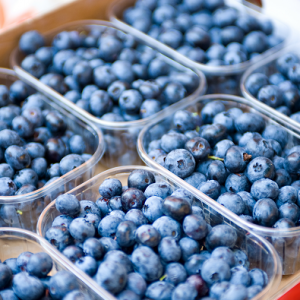U.S.(OR): Blueberry farms close to breaking record
One of the earliest blueberry harvests in decades is now underway in Oregon and, by the end of the season, it could be one for the record books. A mild winter and spring has led to excellent growing conditions. Combined with an increase in acres planted in blueberries, everything is ripe for a giant crop of the usual high-quality fruit.
“This could be the year we finally hit the 100 million pound mark for Oregon blueberry production,” says Bryan Ostlund, administrator of the Oregon Blueberry Commission. “The Pacific Northwest, in general, is off the charts with blueberry production this year and it’s exciting to see.”
The old record for Oregon blueberry production was set in 2013 at about 93 million pounds. Last year, production dropped a bit as hot weather reduced yields. Considering that less than 50 million pounds were produced a decade ago– and even that was a record at the time– well, it’s easy to see that these are heady times for Oregon blueberry growers.
“Our blueberry industry has truly been one of the bright spots in Oregon agriculture for more than a decade,” says Oregon Department of Agriculture Director Katy Coba. “It’s not every day you find a commodity that has shown the kind of rapid growth in production that we’ve seen with our blueberries.”
Blueberries continue to be an Oregon success story, even if the state has lost a little ground in national rankings. About 9,300 acres produced 86.1 million pounds at a value of more than $106 million. Georgia emerged as the national leader in blueberry production followed by Washington, Michigan, then Oregon.
But this could be the year the state emerges as the nation’s top blueberry producer, or close to it.
blueberries_stagedBlueberry harvest normally shifts into high gear after the Fourth of July. This year, production is at least three weeks ahead of schedule. With different varieties of blueberries planted around the state, the picking should continue well into the fall, which means Oregon consumers can enjoy fresh local blueberries for several more months– and beyond, if they consider freezing some of the berries.
“Consumer markets have continued to grow,” says Ostlund. “The per capita consumption of fresh blueberries over the last five to six years has grown tenfold. While we see larger volumes go into the fresh market, we are seeing even larger volumes go into the freezer.”
Last year, direct sales from the grower to the consumer– largely through farmers’ markets and roadside stands– reached 4 million pounds in Oregon. That doesn’t take into account fresh local blueberries sold at retail stores.
Great tasting Oregon blueberries are being used in baking mixes and as an ingredient in other food products. And with more Oregon blueberries being frozen, the fruit is consumed year around.
It’s the consumer that started this frenzy of activity for blueberry growers. Per capita consumption has increased in recent years not only in North America, but in Europe and Asia largely because of the blueberry health message– especially helpful in dealing with such issues as child obesity and the baby boom generation rapidly moving into retirement years. In the 1990s, a Tufts University study showed blueberries to have higher antioxidant activity than all other fruits and vegetables. Antioxidants neutralize the effects of free radicals– those unstable compound molecules that can attack human cells and damage DNA.
In Asia, McDonald’s deep fried blueberry pie was first touted by consumers as being healthy. Since that time, consumers worldwide have developed a better understanding of what they are eating, where it is coming from, and the nutritional values those foods contain.
“The health benefits of our fruit is the overriding reason for our success in the marketplace,” says St. Paul grower Doug Krahmer, a member of the State Board of Agriculture. “At the same time, health benefits alone will not sell fruit. The taste, convenience, and quality has to be high to continue selling our fruit at a price growers can make a profit.”
There are even non-food products making use of the Oregon blueberry. Several health and beauty-related products use blueberries as an ingredient in dermal creams to treat wrinkles and restore good skin color.
Pet owners have been paying attention to the diet of their companion animals. As a result, blueberries have become an ingredient in various pet food products.
With more Oregon blueberries on the market these days, exporting increases in importance. In 2011, a trade agreement was reached that made Oregon the first state allowed to ship fresh blueberries into South Korea. The first containers of this year’s crop are already headed across the Pacific.
“This is the fourth season we are shipping fresh blueberries to Korea,” says Ostlund. “Last year, we shipped about a million and a half pounds. We could easily double that amount this year.”
South Korea is now the top export market for Oregon blueberries, but Japan, the Philippines, Taiwan, and Vietnam are key markets as well.
The demand for blueberries has changed the landscape of the Oregon farms that produce them. In the late 1990s, the average size blueberry farm was about 10 acres. There are still plenty of smaller operations, but now it’s not uncommon to see a farm growing 500 or 1,000 acres of blueberries.
An expected record setting harvest and another 10 million pounds or so of berries this year should push the overall value of production past last year’s mark and perhaps lift blueberries into Oregon’s top ten of all agricultural commodities.
All that fruit puts the consumer in position to get a great tasting Oregon blueberry at a good price.
“Take advantage of the early season,” says Ostlund. “Ample fruit is available. If you like blueberries, now is the time to get them.”
08/10/2015
Natural Report Resource






